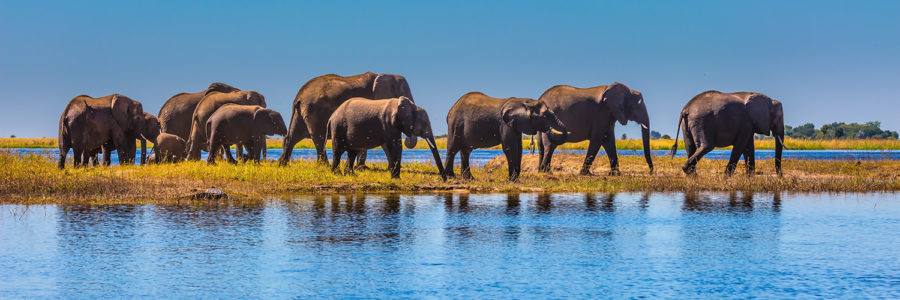
About The Chobe River
The Chobe River is vitally life-giving to the otherwise semi-arid landscape of Botswana, which is landlocked in its location near the center of the southern African subcontinent.
The Chobe River is part of an intricate river system that flows through south-central Africa. Beginning as the Cuando River, it runs along the northern border of Botswana into the Linyati Swamp before changing into the Linyati River, then becomes the Chobe River before merging into the Zambezi River — an interlocking network of waterways that even flows in reverse at times!
As the northern boundary of the Chobe National Park, the Chobe River is home to huge elephant concentrations (up to 50,000) that occur during the winter dry season, which runs May through October. The park boasts some of the best game viewing in Africa, with one of the most substantial populations of wildlife, including lion, hyena, cheetah, antelope, gazelle, hippo, crocodile, and more than 450 bird species.
For birding enthusiasts, the Chobe area is spectacular in the wet summer months when the migrating birds are in full color. Whatever the season, game-viewing and bird-watching cruises on the river have become the most popular way to witness the stunning panorama of Africa’s wild heart, while enjoying thoroughly modern style and comfort.
Chobe River Stats
Length: 83 miles
Depth: Average 10 feet
Source: Liambezi Lake, Namibia
Mouth: Zambezi River near Victoria Falls where Botswana, Namibia & Zambia meet
Locks: 0
Countries: Namibia | Botswana
More about the Chobe River of Africa
The Chobe River, flowing through southern Africa, is a waterway of immense ecological importance. Stretching approximately 170 kilometers, it meanders through Namibia, Zambia, Zimbabwe, and Botswana before converging with the Zambezi River. This river is not just a geographical feature but a lifeline for the region’s wildlife, a source of sustenance for local communities, and a remarkable destination for travelers seeking a unique safari experience. In this 6000-character exploration, we will delve into the Chobe River’s significance, its natural beauty, the diverse ecosystem it sustains, and the challenges it faces in the modern world.
Geography and Formation
The Chobe River’s journey begins in the Angolan highlands, where it flows eastward into Namibia. It then curves southward, forming the border between Namibia and Botswana, before entering Botswana entirely. As it continues to snake its way southward, it eventually merges with the Zambezi River near Kazungula. This confluence marks the point where four countries meet, creating a geographical and ecological crossroads of sorts. The river’s formation is largely attributed to the tectonic movements in the Earth’s crust and the uplifting of the surrounding land. Over millions of years, the Chobe River has carved its path, creating a unique ecosystem along its banks.
Ecological Significance
The Chobe River’s significance lies primarily in its role as a vital water source in an otherwise arid region. Southern Africa experiences a distinct dry season, and the river is a critical watering hole for a wide range of animals. During the dry months, large herds of elephants, buffalo, zebras, and other wildlife congregate along its banks, creating one of the most spectacular wildlife gatherings on the continent. The Chobe National Park, which encompasses much of the riverfront, is a sanctuary for a diverse array of species. In addition to the iconic African elephants, the park is home to lions, leopards, hippos, crocodiles, various antelope species, and over 450 bird species. The river’s lush vegetation provides valuable food and shelter for this abundant wildlife. The river’s floodplains are particularly crucial for the Chobe’s ecosystem. During the wet season, the river overflows onto the floodplains, depositing nutrient-rich sediments and creating fertile grazing grounds for herbivores. This cyclical ebb and flow of water sustains life in the region and has earned the Chobe River its reputation as an ecological jewel.
Tourism and Conservation
The Chobe River has become a hub for ecotourism and wildlife enthusiasts from around the world. Visitors can experience the river’s grandeur by embarking on boat safaris, which offer a unique perspective on the wildlife and landscapes. The Chobe’s riverbanks are dotted with lodges and camps, providing tourists with a front-row seat to nature’s drama. However, this surge in tourism also brings challenges to the region. Balancing the needs of the local communities, conservation efforts, and the tourism industry is a complex task. Responsible tourism practices are essential to ensure the long-term sustainability of the Chobe’s ecosystem. Conservation organizations and national park authorities are working tirelessly to protect the Chobe’s fragile environment. Initiatives such as anti-poaching efforts, community-based conservation programs, and sustainable tourism practices are helping safeguard this natural wonder.
Challenges and Threats
Despite its importance, the Chobe River faces several threats that endanger its ecosystem. Climate change is altering rainfall patterns, leading to increased variability in water levels. Prolonged droughts followed by intense floods can disrupt the natural balance of the river and its floodplains, impacting the wildlife that relies on them. Human activities, such as deforestation, agriculture, and mining, can lead to soil erosion and pollution, which affect water quality and disrupt the river’s fragile ecosystem. Overfishing is also a concern, as it can deplete fish stocks and harm the river’s biodiversity. Additionally, the ever-increasing demand for water resources for agriculture and human consumption can reduce the Chobe’s flow, further stressing the ecosystem and the communities that depend on it.
